Used Snowmobile Review: 2003 Yamaha SX Viper

The end of Yamaha's two-stroke sled era
New snowmobile reviews are the backbone of Snowmobile.com, but not everybody is in the market for a brand new sled. With this in mind, we offer our Used Snowmobile Review article series that features models from a few years back that we think offer good value and will appeal to those looking for a previously enjoyed snowmobile, like those you’ll find in our Classifieds. –Ed.
Yamaha’s early 2000 turn of the century SX Viper snowmobiles marked the end of an era for the Japanese snowmobile company. Introduced as a 2002 model, the SX Viper brought excitement as it used a modified and slightly less potent version of the high-performance SRX 700cc triple, but came with a newer platform and a lower price. The first pre-production models offered to the snowmobile media performed better than the later full production versions would, but it was that first impression that garnered great reviews for the sled and drove subsequent sales.
That process of supplying quick running sleds to the media was nothing new. And probably, in Yamaha’s case, not overtly deceitful as the company prides itself on long term quality. We suspect the final production versions gained some engineering tweaks that downplayed sheer performance in favor of reliability and longevity. That seems to be Yamaha’s history. As it turned out, the production Vipers could easily make 122 horsepower on the dyno at 8500 revs. The engine developed peak torque of 76 lbs-feet from 7100 through 8200 rpm. That was a very wide power band for a 2002 model year snowmobile.
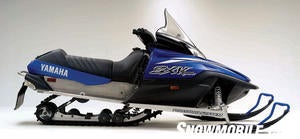 Yamaha’s two-stroke performance Viper helped bridge the move from two-stroke power to four-strokes.
Yamaha’s two-stroke performance Viper helped bridge the move from two-stroke power to four-strokes.
Yamaha engineers developed the Viper triple by starting with the SRX crankcase, even matching that engine’s bore and stoke, but tweaking the innards. The Viper engine block was actually lighter than the SRX and the Viper cylinders were recast to shave mass on the exhaust side and to reflect the redesign of the ports. And, though the two engines shared the crankshaft design, engineers managed to find ways to remove 1.5 pounds of rotating mass from the Viper triple.
Using a new hood design featuring vents that forced an increased flow of air at speed, the Viper actually could gain as much as three horsepower, which could not be seen on a standstill dyno run, unless the room was pressurized to emulate that flow.
Yamaha engineers equipped the Viper with a rack style carburetor setup, using three Mikuni TM33 carbs that were vented to the new airbox. It was said to allow the engine to run cleaner at low end as the float bowl pressure was lower to match the influx of air into the new airbox. The end result eliminated engine bogging under full acceleration and smoothed out overall performance.
Designed to be Yamaha’s hot rod for the early 2000s, the SX Viper would serve that purpose as two-stroke engine technology gave way to the oncoming four-stroke commitment Yamaha would make starting with the RX-1 in 2003. The Viper would evolve a bit, but ultimately it would be shunted aside in favor of four-strokes. By 2003, the Viper had become the subset for trail technology and the RX-1 and its offshoots were listed as “ultimate technology” in Yamaha consumer materials. The Viper line included the trail performer, an electric start equipped Viper ER and the Viper Mountain, which actually performed quite well with its 144-inch track and two-inch lug profile.
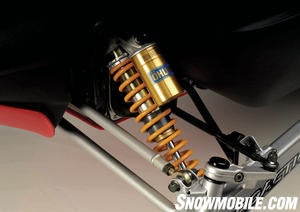 Yamaha’s Viper S featured Ohlins “clicker” shocks and a bellypan protector.
Yamaha’s Viper S featured Ohlins “clicker” shocks and a bellypan protector.
The Viper settled into Yamaha history as late model features like the addition of Ohlins “clicker” shocks and a standard issue bellypan protector distinguished the 2004 Viper S. By this time the four-stroke line had expanded from a high-performance trail model RX-1 (with or without reverse) and a long tracked mountain version, the RX-1 MTN. The 2004 four-stroke lineup included the addition of the rough trail oriented RX Warrior with a 136-inch Camoplast Rip Saw track. The Viper stayed in the model mix as Yamaha transitioned from the two-stroke models to the world of four-strokes.
Perhaps, lost in the transition is the fact that the Viper had become a very nice trail performance unit with a smoothly powerful two-stroke triple and a good performing mogul-bashing rear suspension, the Proaction SXV with aluminum-body gas shocks and 11.5-inches of rear travel. The Viper’s trailing arm front suspension was the end of the evolutionary scale for Yamaha’s two-stroke trail performance models. Equipped with KYB gas shocks, the independent design allowed the sled to plant its skis in the corners for secure speed handling. We recall the Viper as a very precise handling sled with ample two-stroke power that contained an ample reserve for exiting quickly out of the corners.
The Viper was quite a contrast to the four-stroke RX-1, as it seemed lower and more nimble on the trail, perhaps, a reflection of the four-cylinder RX-1’s added weight carried over the skis.
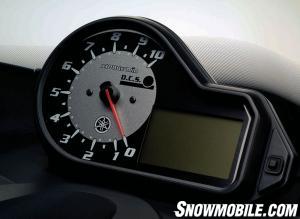 The Viper’s digital gauges started a trend.
The Viper’s digital gauges started a trend.
As we look ahead to the 2012 snowmobiles, we can smile as we look back a decade and reflect on where Yamaha has been. The two-stroke Viper competed well against its contemporaries like the Polaris 800 and 700 XC SP, the Ski-Doo MXZ 800 and 700 as well as Arctic Cat’s ZR and ZRT models.
The Viper style offered a sense of on-snow flair decked out in its Yamaha blue with contrasting aluminum suspension pieces and sitting low and lean with its dual headlights tucked under a widened windshield. It was a quick runner with a readily adjustable rear suspension that could be fine tuned by tweaking the suspension’s control rods.
Built with solid Yamaha quality, 2003 and later year Vipers now would make a good, reliable “back up” sled or a fine low cost entry into snowmobiling. We have seen pricing for “good to excellent” condition 2003-era Vipers offered with asking prices from the high $2000 to mid and upper $3000 range (A 2002 Yamaha SX Viper recently sold in the Snowmobie.com Classifieds for $2,990). Depending on what you want, the last of Yamaha’s two-stroke trail performance sleds may well be collector sleds in the coming decade. They helped Yamaha make the jump from the two-stroke world to the four-stroke world quite well.
| 2003 Yamaha SX Viper Specs | |
| Engine | Yamaha 696cc, two-stroke triple; Bore & stroke: 69.0mm x 62.0 mm; Three Mikuni liquid-heated TM33 carbs; single exhaust with power valve; forced air induction |
| Horsepower | 120+ |
| Drive | YamahaYVXC drive & driven |
| Front Suspension | Yamaha trailing arm with KYB gas shocks; up to 9-in travel |
| Rear Suspension | Yamaha ProAction SXV parallel rail slide suspension with adjustable control rods; KYB aluminum gas shocks; up to 11.5-in travel |
| Length | 109.0 in |
| Height | 48.4 in |
| Height | 47.2 in |
| Ski Stance | 42.1 in |
| Track | 15 x 121 x 1.0 rubber |
| Brake | Hydraulic disc |
| Weight | 489 lbs (claimed) |
| Fuel Capacity | 12.0 US Gal |
| Features | Electric fuel gauge; digital speedometer/odometer/trip meter; |



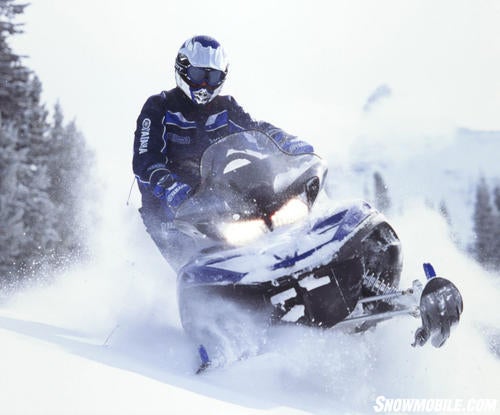
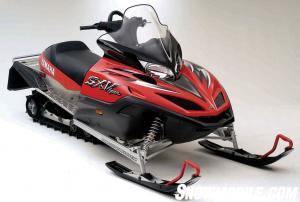





 Your Privacy Choices
Your Privacy Choices